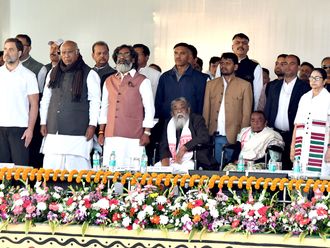
The moment Swades begins, you realise the film is older than you thought. It was made before — just before — India and the world were at the cusp of great transformation.
Nasa scientist Mohan Bhargav flies back to India to find the nanny who raised him. He has to make some effort to find her: she’s not at the old age home and finding her village with paper maps isn’t easy, especially when a pretty girl leads him astray.
That’s how the movie begins. If this was a movie made in 2023, he would probably have been able to find the old nanny, now living in a village, through social media alone.
Charanpur, the imaginary village, is near Azamgarh in eastern Uttar Pradesh, or Purvanchal. It does not seem very accessible by road, has no internet connectivity, it is a Herculean task to make international calls from there, there is very little electricity supply, and the village is so steeped in casteism that some don’t send their children to school to prevent intermingling with other castes.
All of these problems today have been ameliorated to a great degree.
Two decades later
In the last 19 years, since the movie came out, even backward regions like rural East UP have experienced great strides in infrastructure development. Villages have roads and highways are coming ever closer to the village. The roadside tea stall has replaced the village square as the lively place people hang out in.
Caste discrimination has reduced in many ways. For Dalits who face untouchability and are landless, the rural employment guarantee law that came into force a few years after Swades came out, has been a lifeline. The law helped reduce their dependence on landed castes and gave them some leverage to negotiate better wages.
Smartphones are ubiquitous today, even if women and the very poor still don’t have them. If Swades was made in 2023, Mohan Bhargav would have been able to direct the village folk on video call about how to make their own micro-hydroelectric power plant. Not that this would be needed: power cuts may still happen but not so much that daily life is affected.
India today is a power surplus country, but poor financial management of power distribution companies by state governments might still mean some power cuts.
“Swades” shows a rural India so distanced from the modern world that it needs a Nasa scientist to come and solve the people’s problems. The state is, of course, absent.
Shrinking time
Rural India does not appear as distant as it used to in 2004. Roads and highways do exactly what the internet does: reduce distances. The city, the airport, the foreign country, all appear less far than they used to.
Even before the internet revolution, it was the cable TV revolution that reduced the distance between village and city: people started watching the same terrible TV shows as urban India. With the internet, the world seems accessible. Rural India no longer feels like visiting the last century.
Thatched roofs have become a rare sight, the ugly sea of concrete is better at protecting people from weather extremes. Caste remains a shameful reality but the intensity has declined.
One might regularly see stories of children refusing to eat midday meals cooked by Dalits but you won’t see upper castes not sending their children to school because they’ll have to share the classroom with lower-caste children. For the most part.
There was a time when the top 3 problems in India used to be “roti, kapda, makaan” (food, clothing and housing). By the time Swades was made, our problems were ‘bijli, sadak, pani’ (electricity, roads and water). Today these have been largely addressed.
When you are living through change, it feels like being in a slow-motion picture. Watching Swades is like opening a family album, watching black and white photos of family members. The grandparents looked so young, and they dressed so formally. You appreciate the present by taking a look at the past.
If Swades was made today
If a film like Swades is made today, the top three issues to address will be ‘swastha, shiksha, naukri’ (health, education, jobs).
Swades shows Shahrukh Khan’s character go around the village persuading people to send their children to school. Today enrolment is not a problem. It was solved to a great extent by the “Sarva Shiksha Abhiyan”.
But today the problem is retention, preventing drop outs, improving the quality of education, making English medium available to students for a service economy, and giving skill training to prepare a workforce for modern manufacturing.
There is no scene in the movie showing lack of access to health care. This is a big issue today, and especially in the poor states of UP and Bihar. We don’t have enough doctors or hospitals. The government is trying to fix this with health insurance schemes and new medical colleges.
If a Nasa scientist returned to his Indian village today, the number one problem he would be struck by is youth unemployment.
Swades today is considered a cult movie, and one of Shahrukh Khan’s best performances. But when it came out in 2004, it bombed at the box office.
If director Ashutosh Gowariker, if he is feeling bold, might today want to make a movie in which Mohan Bhargav returns from Nasa to solve youth unemployment.
It’s a problem waiting for a hero.








_resources1_16a45059ca3_small.jpg)

